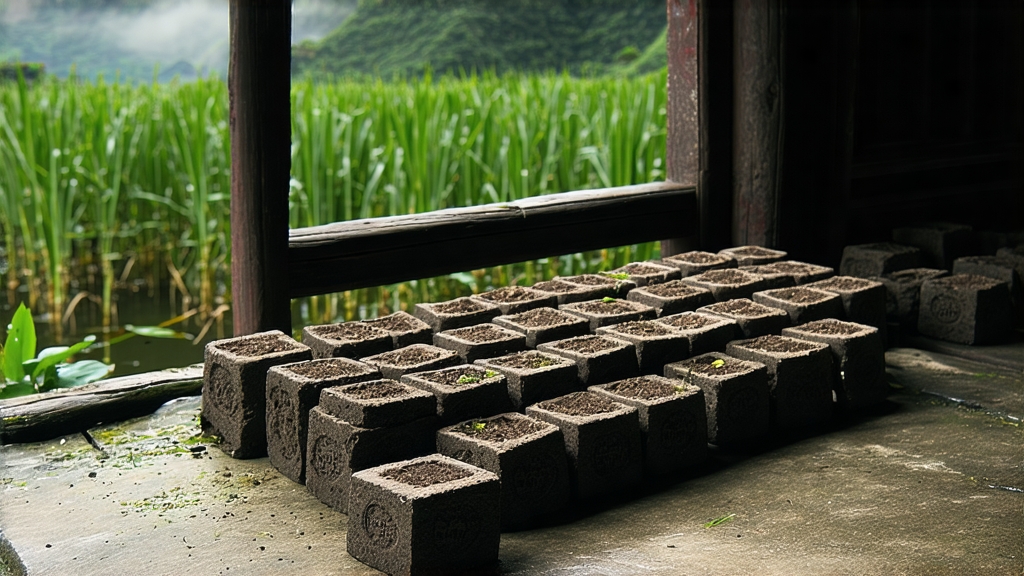
Tucked away in the subtropical mountains of southern China, Liu Bao cha is the quiet diplomat of the dark-tea world. While Pu-erh grabs headlines, Liu Bao has spent four centuries refining a language of deep forest, molasses and betel-nut that now speaks fluently to a new generation of global tea drinkers. To understand it is to witness how microbes, miners and monsoons conspired to turn simple tea leaves into a living time-capsule.
-
From Miners to Merchants: A Cantonese Trade Route
The story begins in the small county of Cangwu, Guangxi, where the Wuzhou port once funneled goods between the Pearl River and the ancient Ling Canal. During the Qing dynasty, miners descending into the hot, humid tunnels of nearby lead and tin mines wanted a tea that would “cut the damp” and settle stomachs battered by greasy camp food. Caravans carried compressed bamboo baskets of dark, half-fermented leaves upriver to Guangzhou, where the British, Dutch and Persians were waiting. By the late 1800s Liu Bao was listed on the invoices of the East India Company alongside Keemun and Lapsang, its value measured not only in flavour but in the belief that it prevented dysentery on long sea voyages. -
One Leaf, Many Faces: Grades and Styles
Liu Bao is not a single recipe but a spectrum. The Guangxi standard recognizes five grades—Special, First, Second, Third and Fourth—based on the pluck standard and leaf maturity. Within each grade producers still decide between two stylistic paths: the traditional “light pile” (30–45 days of wet fermentation) that preserves camphor and fruity notes, and the modern “heavy pile” (60–90 days) that pushes the tea into coffee-cacao territory. A further bifurcation occurs after fermentation: the bulk of the tea is pressed into 50 kg bamboo baskets lined with banana leaf, yet a small portion is left loose to age in clay jars, developing a mellower, orchid-like bouquet prized by Hong Kong collectors. -
Crafting the Darkness: A Six-Act Play
Step 1: Pluck under the Mountain Mist
Only the indigenous Da Ye cultivar, with leaves the size of a sparrow’s tongue, is picked in early April when the mountain mist lingers until noon. The cool humidity keeps the cells taut, ready for the bruising ahead.
Step 2: Kill-Green with Pine-Fed Fire
Leaves are pan-fired at 280 °C for three minutes, hot enough to halt oxidation yet gentle enough to preserve the leaf’s waxy cuticle. The pine smoke leaves an almost invisible fingerprint that will later interact with microbes.
Step 3: Rolling on Rattan Mats
A barefoot worker rolls 8 kg of hot leaves in a spiral motion for twenty minutes. The pressure ruptures 30 % of the cells, releasing amino acids that become precursors for the nutty “rice crust” note.
Step 4: Sun-Withering on Banana Leaves
Instead of bamboo trays, the leaves are spread on large banana leaves whose waxy surface reflects ultraviolet light back into the leaf, caramelising the edges and adding a hint of jackfruit.
Step 5: Wet-Pile in Underground Cellars
The pile is built 1.2 m high inside 200-year-old clay-walled cellars whose floors are sprinkled with Wuzhou well water. Temperature is maintained at 55 °C for 40 days while a consortium of Aspergillus niger, Blastobotrys adeninivorans and local yeasts perform a slow disco. Every five days the pile is turned by workers who stamp rhythmically, aerating the core and embedding the future “betel-nut” note.
Step 6: Bamboo-Basket Pressing and Mountain Aging
The fermented tea is steamed for 90 seconds, then packed into plaited bamboo baskets that hold exactly 50 kg—once the standard load for a porter. These baskets are stacked in limestone caves at 75 % relative humidity and 22 °C for a minimum of three years, although connoisseurs chase the 1983 and 1998 vintages whose wrappers carry the ochre bloom of noble rot.
- Brewing the Midnight Liquor
Western parameters often fail Liu Bao; it demands a conversation rather than a recipe. Start with 6 g of leaf in a 150 ml Yixing clay teapot that has been seasoned only with dark teas. Rinse for five seconds to awaken the microbes, then inf